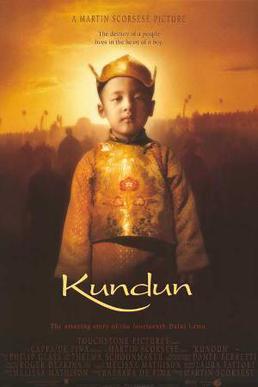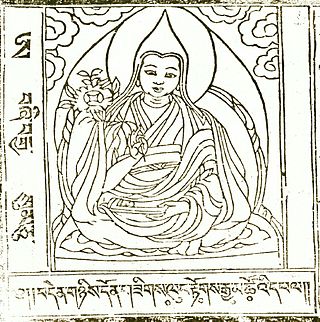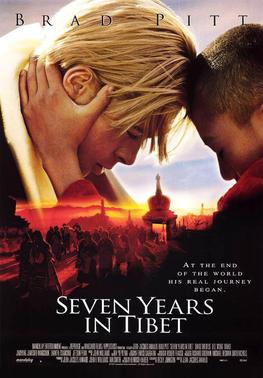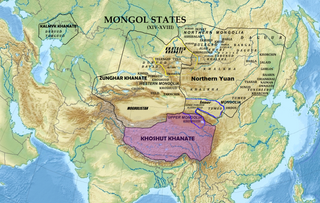Related Research Articles

Dalai Lama is a title given by Altan Khan, the first Shunyi King of Ming China, in A.D. 1578 at Yanghua Monastery to the foremost spiritual leader of the Gelug or "Yellow Hat" school of Tibetan Buddhism, the newest and most dominant of its four major schools. The 14th and incumbent Dalai Lama is Tenzin Gyatso, who lives in exile as a refugee in India. Dalai Lamas are tulkus who are believed to be incarnations of Avalokiteśvara, the bodhisattva of compassion.

The Gelug is the newest of the four major schools of Tibetan Buddhism. It was founded by Je Tsongkhapa (1357–1419), a Tibetan philosopher, tantric yogi and lama and further expanded and developed by his disciples.
A tulku is a distinctive and significant aspect of Tibetan Buddhism, embodying the concept of enlightened beings taking corporeal forms to continue the lineage of specific teachings. The term "tulku" has its origins in the Tibetan word "sprul sku", which originally referred to an emperor or ruler taking human form on Earth, signifying a divine incarnation. Over time, this term evolved within Tibetan Buddhism to denote the corporeal existence of highly accomplished Buddhist masters whose purpose is to ensure the preservation and transmission of a particular lineage.

Kundun is a 1997 American epic biographical film written by Melissa Mathison and directed by Martin Scorsese. It is based on the life and writings of Tenzin Gyatso, the 14th Dalai Lama, the exiled political and spiritual leader of Tibet. Tenzin Thuthob Tsarong, a grandnephew of the Dalai Lama, stars as the adult Dalai Lama, while Tencho Gyalpo, a niece of the Dalai Lama, appears as the Dalai Lama's mother.

The 13th Dalai Lama, Thubten Gyatso was the 13th Dalai Lama of Tibet, enthroned during a turbulent modern era. He presided during the Collapse of the Qing Dynasty, and is referred to as "the Great Thirteenth", responsible for redeclaring Tibet's national independence, and for his national reform and modernization initiatives.

The 9th Dalai Lama, Lungtok Gyatso, was recognized as the 9th Dalai Lama of Tibet. He was the first and the youngest Dalai Lama among four successive Dalai Lamas whom succumbed to illnesses before reaching twenty-two years of age.

Seven Years in Tibet is a 1997 American biographical war drama film directed by Jean-Jacques Annaud. It is based on Austrian mountaineer and Schutzstaffel (SS) sergeant Heinrich Harrer's 1952 memoir of the same name, about his experiences in Tibet between 1944 and 1951. Seven Years in Tibet stars Brad Pitt and David Thewlis, and has music composed by John Williams with a feature performance by cellist Yo-Yo Ma.

Lha-bzang Khan was the ruler of the Khoshut tribe of the Oirats. He was the son of Tenzin Dalai Khan (1668–1701) and grandson of Güshi Khan, being the last khan of the Khoshut Khanate and Oirat King of Tibet. He acquired effective power as ruler of Tibet by eliminating the regent (desi) Sangye Gyatso and the Sixth Dalai Lama, Tsangyang Gyatso, but his rule was cut short by an invasion by another group of Oirats, the Dzungar people. At length, this led to the direct involvement of the Chinese Qing dynasty in the Tibetan politics.

Jamyang Norbu is a Tibetan political activist and writer, currently living in the United States, having previously lived for over 40 years as a Tibetan exile in India.

The Tibetan Institute of Performing Arts (TIPA) was founded by Tenzin Gyatso, the 14th Dalai Lama on reaching McLeod Ganj, Himachal Pradesh, India in exile from Tibet in August 1959. It was then called Tibetan Music, Dance and Drama Society, which was one of the first institutes set up by the Dalai Lama, and was established to preserve Tibetan artistic heritage, especially opera, dance, and music.
Sonam is a given name. It is a Tibetan name meaning "merit". Separately, it is also a name in various Indo-Aryan languages.

The 14th Dalai Lama, Tenzin Gyatso, full spiritual name: Jetsun Jamphel Ngawang Lobsang Yeshe Tenzin Gyatso, also known as Tenzin Gyatso; né Lhamo Thondup; is the incumbent Dalai Lama, the highest spiritual leader and head of Tibetan Buddhism. Before 1959, he served as both the resident spiritual and temporal leader of Tibet, and subsequently established and led the Tibetan government in exile represented by the Central Tibetan Administration in Dharamsala, India. The adherents of Tibetan Buddhism consider the Dalai Lama a living Bodhisattva, specifically an emanation of Avalokiteśvara or Chenrezig, the Bodhisattva of Compassion, a belief central to the Tibetan Buddhist tradition and the institution of the Dalai Lama. The Dalai Lama, whose name means Ocean of Wisdom, is known to Tibetans as Gyalwa Rinpoche, The Precious Jewel-like Buddha-Master, Kundun, The Presence, and Yizhin Norbu, The Wish-Fulfilling Gem. His devotees, as well as much of the Western world, often call him His Holiness the Dalai Lama, the style employed on his website. He is also the leader and a monk of the Gelug school, the newest school of Tibetan Buddhism, formally headed by the Ganden Tripa.

Jigdal Dagchen Sakya Rinpoche was a Tibetan Buddhist teacher educated in the Sakya sect. He was educated to be the head of the Sakya school of Tibetan Buddhism as well as the successor to the throne of Sakya, the third most important political position in Tibet in early times. Dagchen Rinpoche was in the twenty-sixth generation of the Sakya-Khön lineage descended from Khön Könchok Gyalpo and was regarded as an embodiment of Manjushri as well as the rebirth of a Sakya Lama from the Ngor sub-school, Ewam Luding Khenchen Gyase Chökyi Nyima.
Mipham Sonam Wangchuk Drakpa Namgyal Palzang was a king in Central Tibet. He belonged to the Phagmodrupa dynasty which reigned in Tibet, or parts of it, from 1354 to the early 17th century, and was the last prince of the dynasty.

The Khoshut Khanate was a Oirat Mongol khanate based in the Tibetan Plateau from 1642 to 1717. Based in modern Qinghai, it was founded by Güshi Khan in 1642 after defeating the opponents of the Gelug school of Tibetan Buddhism in Tibet. The 5th Dalai Lama established a civil administration known as Ganden Phodrang with the aid of Güshi Khan. The role of the khanate in the affairs of Tibet has been subject to various interpretations. Some sources claim that the Khoshut did not interfere in Tibetan affairs and had a priest and patron relationship between the khan and Dalai Lama while others claim that Güshi appointed a minister, Sonam Rapten, as de facto administrator of civil affairs while the Dalai Lama was only responsible for religious matters. Güshi Khan accepted the nominal suzerainty of the Qing dynasty in 1654, when seal of authority and golden sheets were granted by the Shunzhi Emperor. In the last years of the khanate, Lha-bzang Khan murdered the Tibetan regent and deposed the 6th Dalai Lama in favor of a pretender Dalai Lama.

The Tibet Center, also known as Kunkhyab Thardo Ling, is a dharma center for the study of Tibetan Buddhism. Founded by Venerable Khyongla Rato Rinpoche in 1975, it is one of the oldest Tibetan Buddhist centers in New York City. The current director is Khen Rinpoche Nicholas Vreeland, the abbot of Rato Dratsang monastery. Philip Glass assisted with the founding of The Tibet Center. Since 1991 TTC has invited and hosted the 14th Dalai Lama for teaching events in New York in partnership with the Gere Foundation.
Mipham Wanggyur Gyalpo was a king in Central Tibet who ruled in 1604–1613 and belonged to the Phagmodrupa dynasty. His largely nominal reign saw increasing political tumult in Tibet which was related to the political ambitions of the rival Tsangpa dynasty.
Tenzin Dalai Khan was the third khan of the Khoshut Khanate and protector-king of Tibet. He ruled from 1668 to 1696, in the time of the Fifth and Sixth Dalai Lamas.
Gaeboo Achyok or Gyalpo Ajok was a Lepcha chieftain of a principality based at Damsang, presently in the Kalimpong district of West Bengal, India.
Jamyang is a given name. Notable people with the given name include:
References
- ↑ "Siedem lat w Tybecie" (in Polish). Magazyn.N.pl. Archived from the original on 2013-01-13. Retrieved 2012-10-20.
- ↑ "Gyalsey – the legacy of a prince". ThimphuLive.com. Retrieved 2015-12-18.[ permanent dead link ]
- ↑ "Seven Years in Tibet/B-/A. Columbia/1997/125m/WS,ANA 2.35". FilmSonDisc.com. Archived from the original on 2016-03-03. Retrieved 2015-12-18.
- ↑ "Seven Years in Tibet". ReelingReviews.com. Retrieved 2015-12-18.
- 1 2 "First Bhutanese Film Festival, Tuesday 30 April". BudapestTimes.hu. Archived from the original on 2015-12-18. Retrieved 2015-12-18.
- 1 2 "Refined Gyalsey – Legacy of a Prince targets international audience". kuenselonline.com. Retrieved 2015-12-18.
- ↑ "What Remains of Us (2004)". Movies & TV Dept. The New York Times . 2013. Archived from the original on 2013-09-21. Retrieved 2015-12-18.